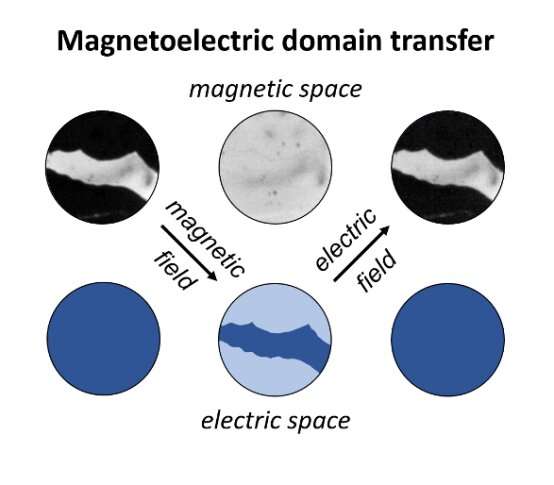Transfer of a domain pattern between magnetization and electric-polarization space achieved for the first-time

Translation of information from one state into another is key to our society. The general purpose of this information transfer is making information accessible, easier to process and to store.
Pictograms—simple signs—direct people to the restroom or signal situations of danger in universally understandable pictures. More complex information requires converting texts from one language into another to make it accessible—the classical form of a translation.
For electronic data treatment, information is typically translated into differently orientated magnetic or electric regions, written, for example, on a computer hard drive. Configurations of these magnetic or electric regions—the so-called domain patterns—represent blocks of information. Just as it is preferable to get an information in several languages, it is of technological advantage to be able to choose between storage in electronic or magnetic space. The basis for such a selection is given in so-called multiferroic materials that host ferroelectric and magnetic order simultaneously.
In a recent article in Science, researchers from the Laboratory for Multifunctional Ferroic Materials at ETH Zurich, one of the cutting-edge groups in multiferroics research, with colleagues from Japan and France achieved for the first-time the transfer of a domain pattern between magnetization and electric-polarization space. This quasi-instantaneous and reversible process differentiates from a mere duplication as it erases the information at the source simultaneously with its recreation at the target. In other words, stored information can be transferred or translated between magnetic and electric space at will.
The researchers also provided the general requirements for such a magnetoelectric transfer. The key is a hidden third state that carries neither a measurable magnetization nor an electric polarization. This hidden state acts as memory buffer and protects the information during the translation.
In terms of applications, the magnetoelectric transfer of a domain pattern opens up perspectives for low-energy information processing, but also to hide or protect information against stray fields or unwanted eyes.
More information: Ehsan Hassanpour et al, Magnetoelectric transfer of a domain pattern, Science (2022). DOI: 10.1126/science.abm3058
Journal information: Science
Provided by ETH Zurich





















